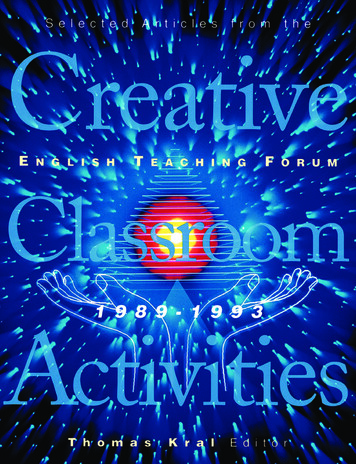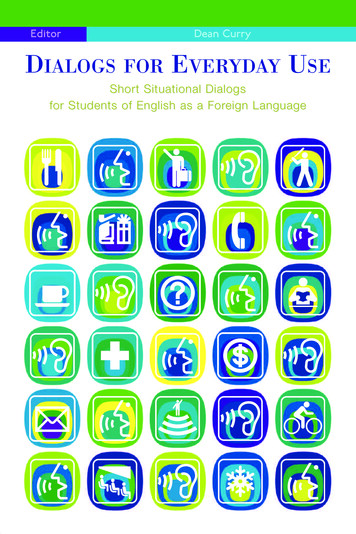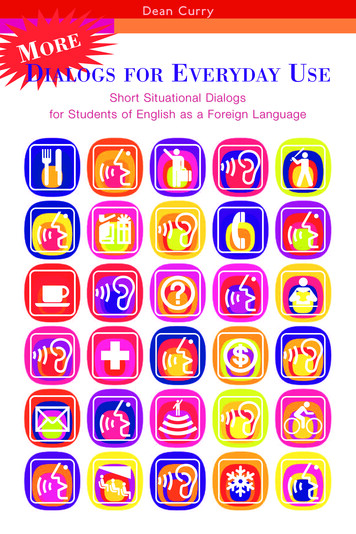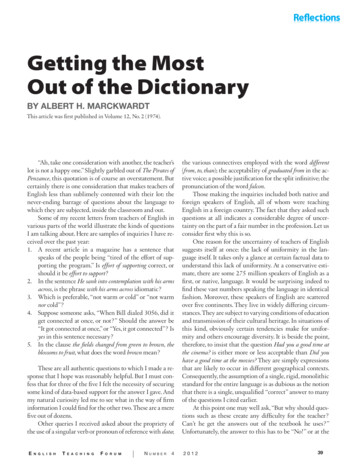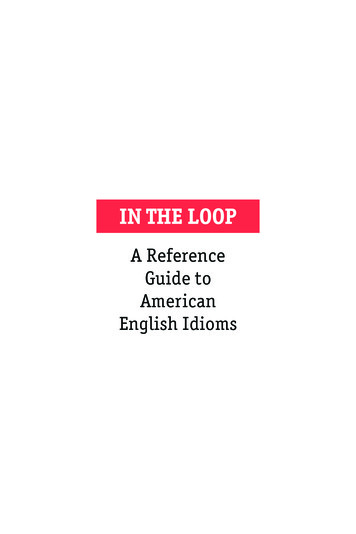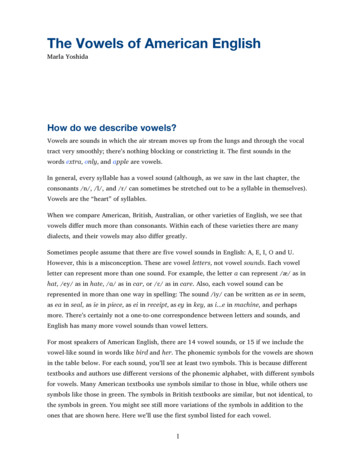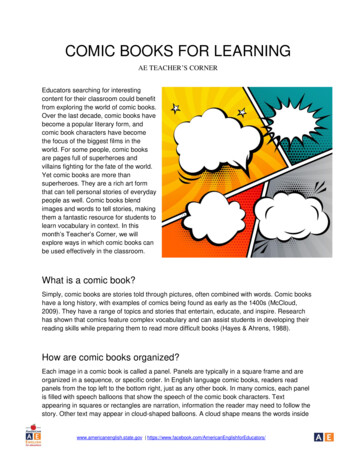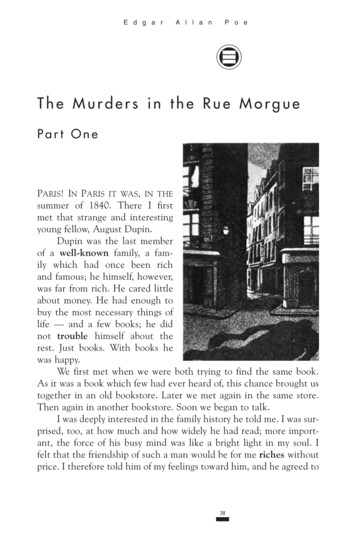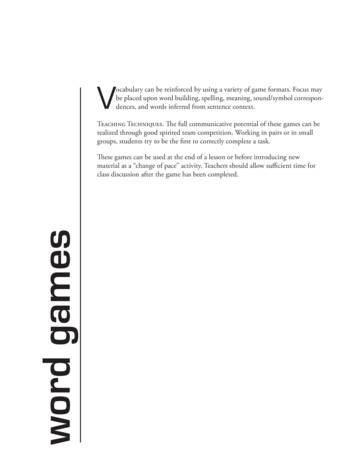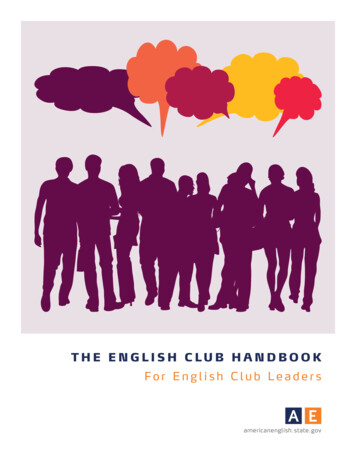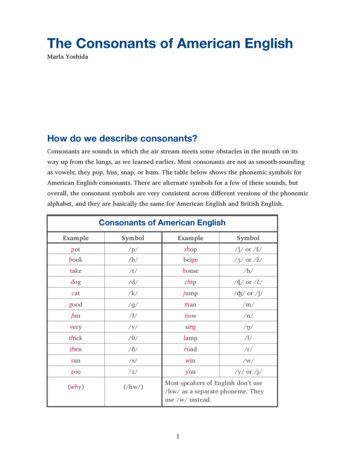
Transcription
The Consonants of American EnglishMarla YoshidaHow do we describe consonants?Consonants are sounds in which the air stream meets some obstacles in the mouth on itsway up from the lungs, as we learned earlier. Most consonants are not as smooth-soundingas vowels; they pop, hiss, snap, or hum. The table below shows the phonemic symbols forAmerican English consonants. There are alternate symbols for a few of these sounds, butoverall, the consonant symbols are very consistent across different versions of the phonemicalphabet, and they are basically the same for American English and British English.Consonants of American EnglishExampleSymbolExampleSymbolpot/p/shop/ʃ/ or /š/book/b/beige/ᴣ/ or /ž/take/t/house/h/dog/d/chip/ʧ/ or /č/cat/k/jump/ʤ/ or /θ/lamp/l/then/ð/road/r/sun/s/win/w/zoo/z/you/y/ or /j/(why)(/hw/)Most speakers of English don’t use/hw/ as a separate phoneme. Theyuse /w/ instead.1
Most words in English contain at least one consonant, and some contain many more. Forexample, at and she each contain one consonant sound, play contains two, and springcontains four. (Remember that we’re counting the consonant sounds, not the consonantletters.) But words don’t have to have any consonants at all. For example, the words I, a,and oh have no consonant sounds—only vowels.Phonologists classify consonants by describing these three sets of categories: Voicing Place of articulation Manner of articulationVoicingWhen the vocal cords are stretched tight so that they vibrate during the pronunciation of asound, we say that the sound is voiced. Sounds that are produced without vibration of thevocal cords are called voiceless. To tell if a sound is voiced or voiceless, touch your throatgently as you say it. When you say a voiced sound, you can feel a vibration or buzzing inyour throat. For a voiceless sound, you can’t. You can also feel the voicing of sounds byputting your fingers in your ears. When you say a voiced sound, it will seem louder. Whenyou say a voiceless sound, it won’t.When you do this with students, try to say only the sound you’re listening to, without avowel after it. For example, to practice /t/, say only /t/, not /tə/ or /tiy/. If you pronouncea vowel after /t/, the voiced vowel will cause vibration and students will be confused andmight mistakenly think that /t/ is voiced.Many of the consonants of English form pairs—a voiced and a voiceless sound that are thesame except for voicing. For example, /b/ and /p/ are identical except that /b/ is voicedand /p/ is voiceless. (Notice that one of these pairs—the voiceless sound /θ/and the voicedsound /ð/—are both spelled with the same two letters: th.) However, the voiced sounds/m/, /n/, /ŋ/, /l/, /r/, /w/, and /y/ have no voiceless counterparts, and the voicelesssound /h/ has no voiced counterpart.The box on the next page shows the voiced and voiceless consonant sounds of English.Paired sounds in boxes next to each other. If a sound has a gray box next to it, it has nopaired sound.2
Voicing of English ConsonantsVoiced ConsonantsVoiceless cksun/ /ship/h/house/t /chipPlace of articulation (Where?)We can also classify consonants by referring to the parts of the articulatory system that areactive when we produce each sound. This is called the place of articulation. As you cansee in the list below, some of these terms are similar to the names of the parts of thearticulatory system that are used in making them. Bilabial: Both lips touch or almost touch. The sounds in this group are /p/, /b/,/m/, and /w/. Labiodental: The upper teeth softly touch the lower lip. The sounds in this groupare /f/ and /v/. Dental (also called interdental): The tip of the tongue touches the bottom edge ofthe top teeth or between the teeth. The sounds in this group are /θ/ and /ð/. Alveolar: The tip of the tongue touches or almost touches the alveolar ridge (thetooth ridge). The sounds in this group are /t/, /d/, /s/, /z/, /n/, and /l/. Palatal (also called alveopalatal): The blade of the tongue touches or almosttouches the hard palate. The sounds in this group are /ʃ/, /ᴣ/, /ʧ/, /ʤ/, /r/, and /y/.3
Velar: The back of the tongue touches the soft palate. The sounds in this group are/k/, /g/, and /ŋ/. Glottal: There is friction in the glottis (the space between the vocal cords). The onlyphoneme in this group is /h/.Manner of articulation (How?)There is often more than one sound that is pronounced in the same part of the mouth, thatis, with the same place of articulation. To distinguish between these similar sounds, we candescribe their manner of articulation. This tells how we produce a particular consonantsound—whether it comes out smoothly or roughly, whether it’s like a pop or a hiss or ahum. The manners of articulation for English consonants are listed below. Stops (also called plosives): The air stream is blocked completely somewhere inthe mouth, air pressure builds up, and then it’s released, like a tiny explosion. Thestops in English are /p/, /b/, /t/, /d/, /k/, and /g/. Fricatives: The air stream is compressed and passes through a small opening in themouth, creating friction—a hissing sound. The air stream is never completelyblocked, so the sound can continue. The fricatives are /f/, /v/, /θ/, /ð/, /s/, /z/,/ /, /ᴣ/, and /h/. Affricates: A combination of a stop followed by a fricative—an explosion with aslow release. The affricates are /ʧ/ and /ʤ/. Each of these symbols is made up oftwo parts—a stop symbol and a fricative symbol. This reminds us that the soundsalso have two parts. Nasals: In these sounds, the tongue or lips block off the vocal tract so air can’t goout through the mouth. Instead, the passage leading up into the nose opens so thatthe air stream can go out through the nose. The sounds in the nasal group are /m/,/n/, and /ŋ/. Liquids: These are sounds that are pronounced very smoothly, like water flowing ina river. The air stream moves around the tongue in a relatively unobstructedmanner. The liquid sounds in English are /l/ and /r/. Glides (also called semivowels): A glide is like a very quick vowel. For this reason,they’re sometimes called semivowels, which means “half-vowels.” They sound likevowels, but they can function as consonants. The glides in English are /w/ (whichsounds like a quick /uw/) and /y/ (which sounds like a quick /iy/).4
Summary: The consonants of EnglishClassification of American English Consonant PhonemesPlace of ArticulationManner �//ʧ//ʤ//m//n/VoicedGlideVelar/l//w//ŋ//r//y/An almost-extinct consonant sound: /hw/Most speakers of English today pronounce the first sounds in weather and whether in thesame way: as the voiced glide /w/. However, until fairly recently, these were two separatesounds. Words like weather, woman, and wish started with a voiced /w/, and most wordsspelled with “wh,” like whether, which, and what, started with a different sound, avoiceless glide that can be represented by the symbol /hw/. Gradually the /hw/ sound hasbeen going out of use. Today the main areas where many people distinguish these twosounds are Scotland, parts of Ireland, and some parts of the Southern United States. In otherareas, some speakers may differentiate between /w/ and /hw/, but most people don’t. Forpronunciation teaching purposes, it’s not necessary to teach students to use the /hw/ soundunless your textbook teaches it.Restrictions on where some consonants can occurMost consonants can appear in all positions in words: At the beginning, in the middle, or atthe end. However, some consonants cannot occur in all positions in words:5
/ŋ/: The consonant /ŋ/ cannot begin a word in English, but there are many wordsthat have it in the middle or at the end: singer, think, song, tongue. /ʒ/: English has only a few borrowed words that begin with the consonant /ʒ/,(genre may be the only common one) and only a small number that end in this sound (beige, garage, prestige). It is more often found in the middle of words: usual,measure, leisure, vision./h/: The sound /h/ cannot occur at the end of a word. When we see the letter h atthe end of a word, it is either silent (oh, hurrah) or part of a two-letter combinationthat spells a different sound (rich, fish, tooth).Syllabic consonantsIn general, every syllable needs a vowel to serve as its “heart.” However, sometimes we canhave a syllable with no vowel if a consonant stretches out longer to replace the vowel. Onlya few consonants are able to do this: /n/, /l/, and /r/.The phonemes /n/ and /l/ most often become syllabic after a stressed syllable that ends inan alveolar consonant: Kítten, bútton, dídn’t, shóuldn’t, kéttle, líttle, ládle, túnnel. (Keepreading to find out about how the /t/ sound can change when a syllabic /n/ comes after it.)In American English, /r/ often acts like a vowel sound in words like her, learn, word, water,and butterfly. In the syllables written in red in these words, we only hear the /r/ soundwith no separate vowel before it. This is different from words like wear, wore, hear, ortired, where we can clearly hear a separate vowel before /r/. Many textbooks use thesymbol /ɚ/ or /ɝ/ to represent this “syllabic /r/,” while others use a double symbol like/ər/ or /ɜr/.Allophones of some consonant phonemesSome consonants are pronounced differently depending on where they are in a word andwhat sounds are around them. (That is, some consonant phonemes have more than oneallophone, depending on their phonetic environment.) Let’s look at the consonantvariations in American English that are most important for you to know about as a teacher:Allophones of voiceless stops: In English, the three voiceless stops, /p/, /t/, and /k/,have allophones that follow the same pattern. (The phoneme /t/ also has some extraallophones.)When /p/, /t/, and /k/ come at the beginning of a word or at the beginning of a stressedsyllable, they are aspirated. That is, they are pronounced with a small puff of air. We can6
represent these sounds by adding a small “h” to the phonemic symbol: [ph] pan, price, potáto, appéar [th] top, táble, togéther, atténd [kh] can, kéttle, compúter, accúseWhen /p/, /t/, or /k/ are in a consonant cluster after /s/ at the beginning of a word orsyllable, they are unaspirated. There is no puff of air when we say them. To representthese sounds, we don’t add anything to their phonemic symbols. [p] span, spécial, spring [t] stop, stáple, string [k] scan, scátter, screenWhen /p/, /t/, or /k/ comes at the end of a word, it is often (but not always) unreleased.This means that we start to say the sound by blocking off the air flow, but we don’t releasethe air. We add a small circle to the phonemic symbol to represent these sounds. [p ] stop, hope, devélop [t ] coat, late, básket [k ] back, lake, stómach(The rules we have just looked at only apply to voiceless stops (/p/, /t/, /k/). Voiced stopsin English (/b/, /d/, /g/) are never aspirated. They don’t have a puff of air in any position.)In addition to these sound variations that work the same way for all voiceless stops, inAmerican English, /t/ has more allophones that /p/ and /k/ don’t have.The first “extra” allophone of /t/ is the sound that we usually hear in American Englishin the middle of words like water, city, and bottle. This is a voiced sound. The tongue tapsthe alveolar ridge very quickly, so that it sounds like a quick /d/. It’s called an alveolar flapor tap, and it’s represented by this symbol: [ɾ]. It’s like the sound represented by the letter“r” in Spanish and many other languages, but it’s different from an English /r/. (For anEnglish /r/, the tongue doesn’t touch the alveolar ridge. For the flap, it does.)When words are pronounced with [ɾ], some words with /t/ sound just like words with /d/: Látter and ládder sound the same. Wríting and ríding sound the same. Métal and médal sound the same.7
When do we pronounce /t/ as a flap? We say it this way only when two things happen: When /t/ comes between two vowels (or vowels followed by /r/). When the syllable before it is stressed, and the syllable after it is unstressed.Look at the examples in the table below. When the stress is before the /t/ sound, it’s a flap.When the stress is after /t/, /t/ is not a flap.Examples of Flaps and Glottal Stops“normal” /t//t/ is a flap/t/ is a glottal lpátternpátentmástermátterManháttanThe second “extra” allophone of /t/ is a glottal stop, represented by this symbol: [Ɂ]. Toproduce this sound, the vocal cords close tightly, air builds up behind them, and then theyopen quickly. It’s like the beginning of a small cough, or the middle sound when we sayhuh-uh to mean “no.”The phoneme /t/ can be pronounced as a glottal stop when two things happen: When the syllable before it is stressed and the syllable after it is unstressed. When the syllable after it is /ən/ or syllabic /n/. (That is, /ə/ disappears and /n/ islengthened and becomes a whole syllable. The symbol for syllabic /n/ is [n̩].)Examples of words in which this happens are listed in the table above.It’s not absolutely necessary for learners to pronounce the flap [ɾ] or the glottal stop [Ɂ]allophones of /t/, but they need to understand them when they hear them. And in normalAmerican English speech, they will hear them often.Light and dark /l/: The consonant /l/ is traditionally said to have two allophones: “light”or alveolar /l/ (with the symbol [l] ) and “dark,” or velarized /l/ (with the symbol [ɫ]),occurring in different positions:8
[l] (light /l/) is found at the beginning of a syllable, especially before front vowels,in words l
In American English, /r/ often acts like a vowel sound in words like her, learn, word, water, and butterfly. In the syllables written in red in these words, we only hear the /r/ sound with no separate vowel before it. This is different from words like wear, wore, hear, or tired, where we can clearly hear a separate vowel before /r/. Many textbooks use the symbol /ɚ/ or /ɝ/ to represent this .File Size: 915KBPage Count: 17

